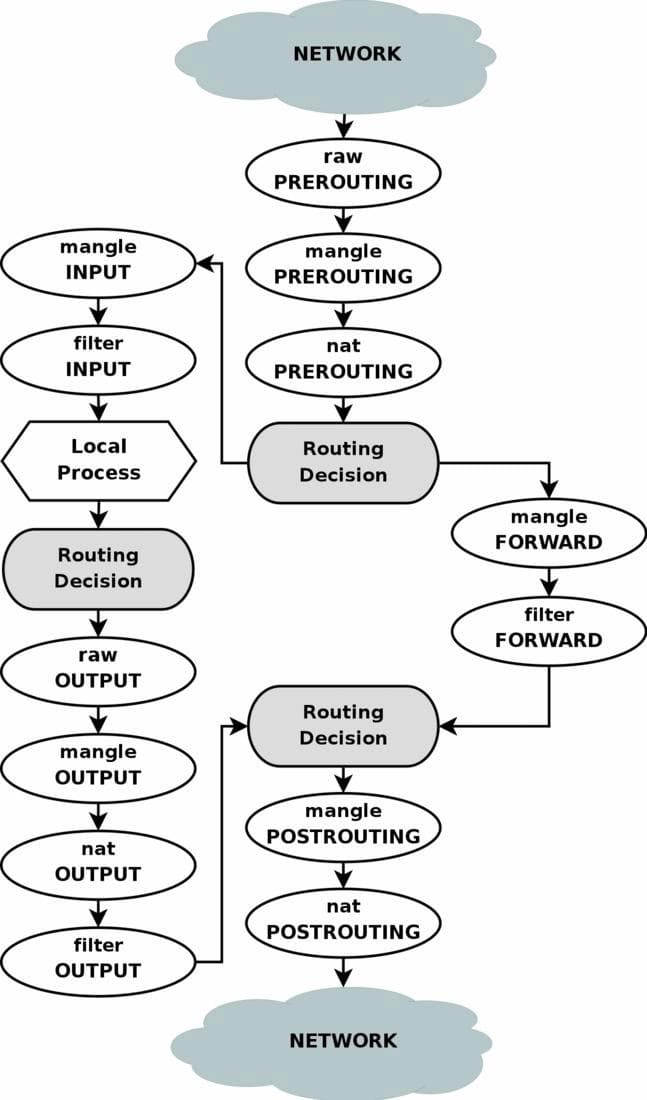Motivation
Recently I had to secure one of my docker setups running in a virtual machine so that only specific ports (or docker containers) are accessible via a specific set of IP addresses on the network. Now, this seems to be a simple task, and mind you it is, but not if you aren’t well versed with iptables and how docker configures it for its network. Since I was unable to find any tutorial for this particular requirement I decided to write one.
**Disclaimer:* I’m quite new to the networking world of Linux and iptables in general, please let me know in the comments if there is an even easier way to achieve this and or any enclosed information is incorrect.*
Exploration
Docker does have a documentation page on how to configure iptables with docker here. And it does outline a way to whitelist a single IP. So yay?… job done? Not quite. It only allows single IP to access ALL ports in the Docker network. Not quite what we need. If that is your use case I suggest you stop reading this any further and go through the documentation, finish your task at hand, and come back if you would like to know how to add restrictions on port level.
Uncomplicated Firewall made complicated by docker?
UFW is an easier and faster way of managing firewalls rules in Linux. Well for one thing it’s in the name — “uncomplicated”. But as I found out with docker UFW is more like CFW or more colloquially known as TFW. I won’t be getting into the details here but because of the way docker manipulates the iptables normal UFW flow won’t work, in fact, it will cause more problems than it solves — learned that the hard way. There are lots of tutorials out there on how to get this to work and even a github project dedicated to extending UFW to support docker. If most of your setup already relies on UFW I suggest you check those out, since for my use-case it seems quite the overkill and I didn’t bother exploring it.
But what the heck are iptables?
Instead of me explaining what they are, which will be a bad job, you can look at the wikipedia page for iptables and very detailed information in the official documentation. The only particulars needed for this post are the following. Iptables mainly have four types of table — raw, mangle, nat, and filter. And they are processed in that order. For more granularity go through the diagram below.
Understanding how docker manipulates iptables
Docker creates two custom iptables chains in the filter table named DOCKER and DOCKER-USER. And all of the communication to docker is validated by these rules. They recommend not changing the DOCKER chain since it is populated by docker networking modules. And prepend (not append) all of the custom validation you might require to the DOCKER-USER chain. The important piece of information which the docker’s documentation page leaves out is that all of the port forwarding rules for the containers are added in the nat table of iptables, and this will be a big gotcha later. To see how the filter table is configured let’s execute the following command.
sudo iptables -L -v
All of the incoming connections related to docker are routed to docker network interfaces, hence any filtering of these connections (or packets) will take place in the FORWARD filter chain. Hence check the FORWARD chain, you will see that the first entry is DOCKER-USER. This means all (because there are no constraints added to the rule) of the packets received to this chain will be passed to the DOCKER-USER chain. So let’s jump to the DOCKER-USER chain, there (by default) you should see just a single RETURN rule with no constraints, which means that filtering will start again from the next rule in the parent chain. If we don’t want to process any packet we will have to filter it before the RETURN rule.
Getting to the point
Let’s recap our objective — only allow a specific ip to communicate with a specific service running on a specific port. You might need this if you have developed a black box that just takes an input and produces output without exposing any implementation details. You would probably want to block all access to the box apart from input and output streams. So let’s say we have two docker containers running — django (at 8080) and postgres (at 5432). And we only want to allow incoming connections to the django server at 8080 and not allow any outside connections to the database.
Don’t allow any outside connections by default
To drop all incoming and forwarded connections by default but allow established connections and all ssh connections execute the following commands. We are assuming that there is only one external network interface (eth0) in the system.
*# Allow loopback connections.*
iptables -A INPUT -i lo -j ACCEPT
iptables -A OUTPUT -o lo -j ACCEPT
*# Allow established and related incoming connections.*
iptables -A INPUT -m conntrack --ctstate ESTABLISHED,RELATED -j ACCEPT
*# Allow established outgoing connections.*
iptables -A OUTPUT -m conntrack --ctstate ESTABLISHED -j ACCEPT
*# Allow all incoming and outgoing SSH connections.*
iptables -A INPUT -p tcp --dport 22 -m conntrack --ctstate NEW,ESTABLISHED -j ACCEPT
iptables -A OUTPUT -p tcp --sport 22 -m conntrack --ctstate ESTABLISHED -j ACCEPT
*# Drop all incoming and forwarding connections by default.*
iptables -P INPUT DROP
iptables -P FORWARD DROP
*# Drop all forwarded connections from the external interface in the DOCKER-USER chain.*
iptables -I DOCKER-USER -i eth0 -j DROP
For more information and reference for these commands visit this handy blog post over at DigitalOcean.
So now if you again check the output of sudo iptables -L -v you will see that for INPUT and FORWARD chain default policy (shown in brackets after the name of the chain) is now set to DROP.
INPUT chain should look something like this.
Chain INPUT (policy DROP 0 packets, 0 bytes)
pkts bytes target prot opt in out source destination
555 416K ACCEPT all -- lo any anywhere anywhere
147 11595 ACCEPT all -- any any anywhere anywhere ctstate RELATED,ESTABLISHED
1 44 ACCEPT tcp -- any any anywhere anywhere tcp dpt:ssh ctstate NEW,ESTABLISHED
DOCKER-USER chain should look something like this.
Chain DOCKER-USER (1 references)
pkts bytes target prot opt in out source destination
0 0 DROP all -- eth0 any anywhere anywhere
16 864 RETURN all -- any any anywhere anywhere
Now all of the packets coming to this chain from the **eth0 interface will be dropped**.
It’s quite lonely here, let someone talk to me
Assuming that we have a static IP (192.168.0.69) from where we would like to send requests to our django server running at port 8080. To allow these requests to be forwarded to the django container execute the following commands.
*# Allow inbound and outbound traffic for 192.168.0.69 IP on 8080 port.*
iptables -I DOCKER-USER -i eth0 -s 192.168.0.69 -p tcp --dport 8080 -j RETURN
iptables -I DOCKER-USER -o eth0 -d 192.168.0.69 -p tcp --sport 8080 -j RETURN
The above commands add two rules stating that any forwarded tcp packets either incoming or outgoing from 192.168.0.69 on port 8080 should RETURN from the DOCKER-USER chain to its parent chain (FORWARD) for further processing and skip any subsequent rules in this chain. Hence those packets are not dropped since the dropping rule comes after them. Now django server should be able to receive requests from that IP address. You can prepend as many rules as you want to allow different IP addresses or complete subnets. The job is done.
But wait there’s a gotcha?
Remember how I told you docker modifies the nat table of iptables as well? Docker handles all of the exposed ports from your containers using it. Let’s see what exactly it does by running the following command.
sudo iptables -t nat -L DOCKER
You should see an output similar to this.
Chain DOCKER (2 references)
target prot opt source destination
RETURN all -- anywhere anywhere
RETURN all -- anywhere anywhere
DNAT tcp -- anywhere anywhere tcp dpt:5432 to:172.18.0.12:5432
DNAT tcp -- anywhere anywhere tcp dpt:8080 to:172.18.0.7:8080
DNAT tcp -- anywhere anywhere tcp
This allows all of the connections made on the exposed ports on the host network to get forwarded to the docker network and its corresponding container.
Do you see the problem here? Let me explain. Since the nat table is processed before the filter table in iptables, if we have specified a different exposed port than the port of the process running inside the docker container we will run into issues while writing our filtering rules.
Let’s say in our example above if the django server was running on port 8080 but we exposed (and or mapped) it as 8081, to not get any interference during development with other django based servers which might be running as well. In this case, if you were to run sudo iptables -t nat -L DOCKER you should see output similar to this.
Chain DOCKER (2 references)
target prot opt source destination
RETURN all -- anywhere anywhere
RETURN all -- anywhere anywhere
DNAT tcp -- anywhere anywhere tcp dpt:5432 to:172.18.0.12:5432
DNAT tcp -- anywhere anywhere tcp dpt:8081 to:172.18.0.7:8080
DNAT tcp -- anywhere anywhere tcp
We would expect to use port 8081 while writing our IP whitelisting rule as described in the previous section. But that won’t work since those packets would have already been forwarded to port 8080 and will violate the constraints of the whitelisting rule. Figuring this out made me scratch my head for a long while. Hence while writing IP whitelisting rules as mentioned above you should use the port number of the underlying docker container and not the host mapped port as you would expect. Even though you would access the django server using port 8081 on the whitelisted IP.
And why should I care about this?
Cause it’s secure.
This is a re-post of my original medium post here.








Top comments (0)